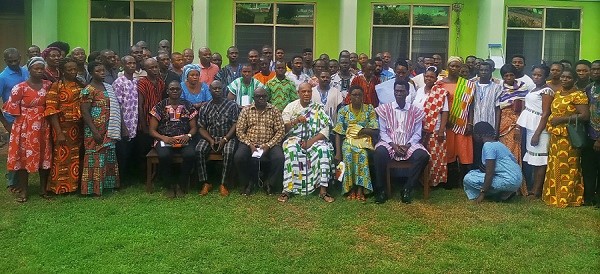
Volta Kete patterns disappearing: Weavers association asks for industry’s protection
The fashion industry in the Volta Region is booming, with various stakeholders cashing in on clothes production, designing, modelling and the notable annual Volta Fashion Awards.
The awards are organised every October to celebrate fashion designers who are one of the major stakeholders in the clothes and garment industry, serving diverse demographics.
Advertisement
As a subset of the industry, kete weaving in the Volta Region is showing a strong potential as huge demands for traditional attires ascend.
Originally called “Ke na Te” in the Ewe language which means “Open” and “Hit”, Kete is an art which dates back to over 300 hundred years. Different patterns of Kete can be found in various communities scattered across the region.
In the eyes of the world, Kete also known as Kente in Akan is regarded as the best hand-woven textile in Ghana and Africa at large.
For Ghanaians, it is often the first-choice gift to any important visitor to the country because apart from its beauty, the patterns and designs also give deeper philosophical meanings to the cultural identity of the people.
The weaving processes
Weaving of the kete cloth entails the crossing of a row of threads with another row horizontally through a loom made of wood.
Pulleys are then used to move the threads apart while the Kete weaver slots in different kinds of thread in different colours in between them until it produces a narrow strip of cloth which is sewn together into a huge cloth size.
In the Volta Region, the economic and cultural values attached to the Kete cloth has birthed the idea of establishing a ‘Kente Village’ at Agotime-Kpetoe (a community well established for the weaving of Kete) to showcase the rich patterns in the region.

Unique Ewe Kete disappearing
The Ewe brand of Kente is, however, quickly disappearing. The brand, which has for decades provided a unique cultural identity for the Ewe people is no longer a common sight to see, especially at social gatherings including weddings and festivals.
Despite the fact that the old patterns are not in vogue, the Agotime Kpetoe community has tried to preserve some of the old patterns and currently boast about 150 of such including Tritriku, Trekake, Atixali, Fialexorme, Gabusu, Fatia, Faprim, Agutemakpa, Tsapim, Tsatsatsa, and Zevideka.
There is tremendous scope for growth in the fashion industry and business, especially with the use of the Kete cloth, which has found a sound footing on the international stage with contemporary combination of other fabrics.
Witnessing this growth, many of the entrepreneurs who are neither fashion designers nor fashion graduates are entering the market to explore opportunities.

The Volta Kente cloth being displayed at a festival
Challenges
Most of the Kete weavers in the region, however, are unable to cash in on these opportunities and are in dire straits due to funding that seems to have eluded them.
In an interview with the Daily Graphic, 32-year-old Nyatefe Kudroha and 35-year-old Asitor John at Ando No. 2 in the Afadjato South District, said the business was lucrative, as they made an average of GH₵ 1,300 from a single order.
They, however, said looking for clients was not a walk in the park, as cloth orders were rare to come by, especially in a business such as theirs which had no external funding.
Though the industry has so many unorganised businesses like that of Kudroha and Asitor scattered across the region, associations are quickly forming and gradually taking up space in the economic environment.
But establishing and managing a business comes with unique challenges as stated by Mr Robert Dzokoto, leader of the Kete Weavers Association of the Volta Region who indicated the need to salvage the industry from pattern imitations while calling on institutions mandated with the implementation of the Intellectual Property Policy to walk the talk.
Efforts, strategies
So far, the Microfinance and Small Loans Centre (MASLOC), has processed about 175 members of the association to receive financial support, with more members in the offing to enjoy a similar facility.
The Volta and Oti Regional Director of MASLOC, Mr Dan Kafui Wudome, said the government recognised the important role of kente in the socio-cultural life of Ghanaians and is, therefore, committed to supporting the kente industry in its growth and expansion, especially for the export market.
Ms Doris Ama Bansah of the Ghana Export Promotion Authority (GEPA) also announced that as part of efforts to strengthen the association, GEPA would in 2020, provide training and capacity building to the weavers on better business management practices and renovate weaving sheds at Kpetoe to promote the kente business, while urging the weavers to register their businesses.
The Sokode-Ando community in the region is also expected to take delivery of a new weaving centre to promote the business as stated by the Ho Municipal Chief Executive, Mr Prosper Pi-Bansah.
There is, however, an ongoing debate on the true origin of kete in Ghana; whether it is Kete signifying Ewe origin or Kente from the Akans, specifically Bonwire in the Ashanti Region.
But as Mr Pi-Bansah, puts it “Kete or Kente is truly Ghanaian and must remain a unifying product for all Ghanaians.”
Kente is a timeless Ghanaian heritage despite controversies surrounding its origin. It continues to be seen as a symbol of national pride.



